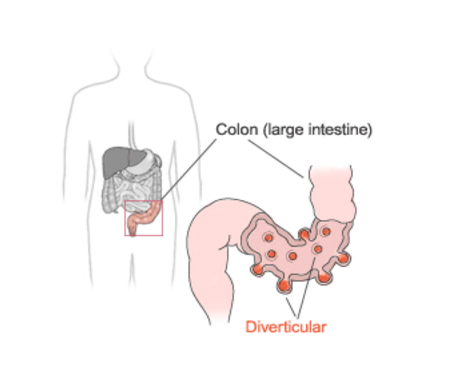Diverticular Disease
Diverticulosis refers to the presence of small out-pouchings (called diverticuli) or sacs that can develop in the lining of the gastrointestinal tract. While diverticula can be present anywhere in the entire digestive tract, they are most common on the left side of the large intestine, the area known as the descending and sigmoid colon.

Diverticulosis Causes
No one knows for certain why diverticulosis develops; however, a few theories have been suggested. Abnormal contraction and spasm (resulting in intermittent high pressure in the colon) may cause diverticula to form in a weak spot of the intestinal wall. Constipation leads to excess intra-colonic pressure and is thought to be responsible for some cases of diverticulosis. A diet rich in fiber (bran cereals, whole wheat bread, fresh fruits, and leafy vegetables) may decrease the development of diverticulosis, improve symptoms of constipation and decrease the likelihood of complications. Benefits of a high fiber diet may be seen in those who eat between 15 and 30grams of fiber a day. Unfortunately people in the United States generally only consume 8-12 grams a day. Diverticulosis does not appear to be associated with alcohol, smoking or caffeine consumption. There also appears to be a genetic predisposition. Once diverticula have formed they do not go away.
Diverticulosis Signs & Symptoms
Most patients with diverticulosis have no symptoms. Many will never know they have the condition until it is discovered during a colonoscopy or radiographic examination. While most people have no symptoms, some individuals may experience pain or discomfort in the abdomen, bloating, and/or a change in bowel habits.
Diverticulosis Risk Factors
Diverticulosis is a common disorder, especially in older people. The condition is rarely seen in people under the age of 30 and is most common in those over 60. Both men and women are equally affected.
Diverticulosis Diagnosis
Diverticulosis is generally discovered through one of the following examinations:
- Colonoscopy
- CT scan
- Barium enema
Diverticulitis is an inflammation and/or infection of one of the diverticula. People with this complication characteristically present with:
- Fever
- Abdominal pain, often on the lower left side
- Diarrhea and/or constipation
- Decreased appetite
Other complications of diverticulitis include the development of an abscess or narrowing of the colon (stricture). In rare cases, a fistula or connection between the bowel and bladder may occur as a complication of diverticulitis.
Hemorrhage or the passage of a large amount of bright red blood from the rectum is another potential complication. It occurs typically without warning and is painless. Severe bleeding has been reported in 3-5% of people with diverticulosis and usually stops without special treatment.
Diverticulosis Treatment
Treatment for diverticulitis (an inflamed or infected diverticulum) requires the use of antibiotics and occasionally hospitalization. Recovery is usually uneventful. Surgery is rarely required but may be needed for cases that don’t respond to medical management.
Individuals with diverticulosis are sometimes instructed to avoid foods that contain indigestible particles such as popcorn, nuts, and fruits with small seeds. The theory is that these particles might get “stuck” in a diverticulum which may then lead to diverticulitis. While there is no objective evidence to support this recommendation, the latest research suggests that eating nuts may reduce the risk of diverticulitis in individuals with diverticulosis.


